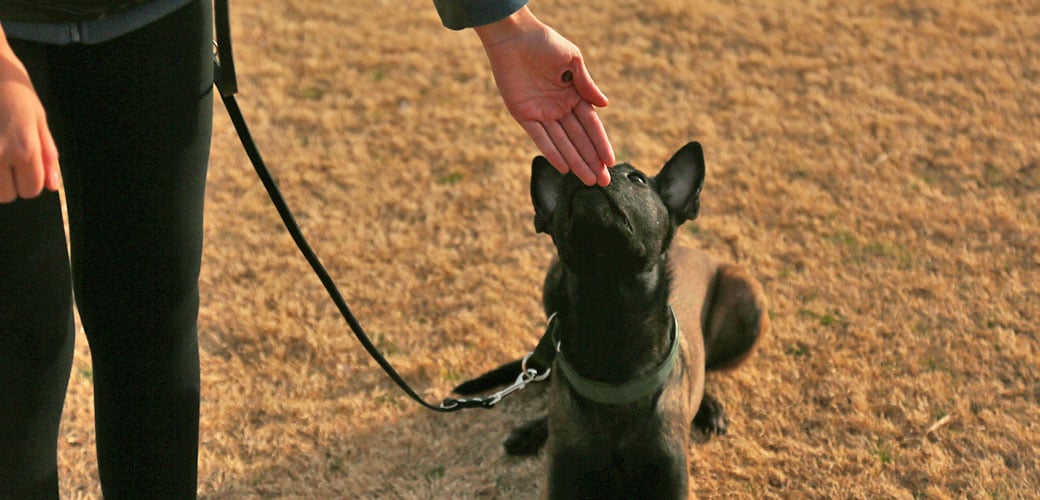
5 Ways to Improve Your Dogs Heel
November 16, 2020
If you have a big dog, or a long dog, like a German Shepherd, it may seem like the two ends of your dog are controlled completely separately! And to a degree, this is true. Your dogs front-end may stay with you perfectly, but his back legs may swing in or out until they eventually drive him out of position, even after months of training.
The best way to get your dog to learn the correct heel position is to focus on problem areas with specific exercises designed to challenge your dogs understanding of the task. Oftentimes, fixing bad habits can take much longer than teaching a task for the first time, and can be somewhat stressful for your dog, so it’s OK to practice shorter sessions than you normally would to keep your dog excited about training.
1. Change Where You Put Your Reward
If you trained your dog to heel by tucking a toy or treat under the opposite arm from the side your dog is on, it’s likely that your dog picked up the bad habit of “crabbing” or swinging his rear end out to anticipate getting the reward. In some dogs, this behavior can be so pronounced that they break their heel position out of excitement and wind up cutting you off when you’re walking just so they can get a little closer to their toy or treat.
One easy way to address this is to change where you put your reward, from your opposite arm to right in front of your dogs nose.

If you have a big dog, it should be fairly easy to keep the treat right in front of their nose, whereas if you have a smaller dog you might want to use a target stick or be prepared to crouch while you’re initially teaching the exercise. The idea behind this technique is to stop your dog getting so excited about “where the ball might be” by simply showing it to them the entire time. Ironically, some dogs struggle more with the ball right in front of them than with it out of sight, so it will really depend on what works with your dog.
When you change where you put your reward, you should practice rewarding the new way (with the ball or treat right in front of their nose) for a few weeks consistently, without putting the treat under your arm during that time, to get a good idea of how well the technique really works for your dog.
2. Practice (Rewarding) Outside Turns
If your dog has trouble keeping up on turns, but does well in a straight line, practice rewarding your dog for outside turns. Outside turns are naturally wider and force your dog to take extra paces to keep up with you, so regular practice can help naturally slow-moving dogs keeping Adding outside turns to your training can help your dog engage his back legs and keep his focus on you for longer, because he isn’t sure when he’ll have to direction next to keep up.
This is also a useful exercise for young dogs who may still be uncoordinated, or may get too excited when they speed up while turning, and break into a run. Practicing outside turns can help teach control and focus and can be added to virtually any training session, especially when kept random so your dog doesn’t begin to anticipate the turn and rush you.
3. Teach Your Dog to Pivot
Pivoting is a useful, albeit indirect skill, when it comes to teaching your dog to heel. Pivoting can be done on a target custom made for dogs, or anything that your dog can recognize and comfortably stand on (like a rug, box. The essence of teaching your dog to pivot is teaching them to keep 2 paws completely still on a target, while still staying in the heel position as you move.
This can be a challenge for dogs to understand, and is exclusively taught with positive techniques. Pivot training is all about waiting for your dog to do the right thing, and then rewarding that immediately with praise and food.
4. Use a Hallway or Obstacle
Switching up your dogs regular training by using hallways or obstacles can really challenge your dogs training and trust in your handling, as instead of naturally looking out for obstacles like he would do on his own, he has to rely on you, and staying in position, to successfully navigate a space.
Using obstacles, like traffic cones or makeshift “trot poles” you can line your dog up with the obstacle to either reinforce the heel you want, or to challenge their existing training in a new situation. For example, if your dog struggles with swinging his rear end outward, you might position yourself so that your dog is between you and a wall or pole, encouraging him to stay aligned with you, because the obstacle makes his bad habit difficult to do. Or if your dog has a great heel and you’re trying to challenge him, practicing heeling right over an obstacle, like stairs, a curb, or a bench can add a new layer of understanding to your dogs existing obedience.
5. Reward More Frequently
Often when a dog develops bad habits during the heel, like rushing ahead of their handler or lagging behind, it's because they were rewarded at the wrong time (or not rewarded at the right time!) which eventually became a habit.
To fix this, and "re-teach" the heel, start rewarding your dog more frequently. Even a trained dog can benefit from more frequent rewards, including food rewards or toys, depending on what your dog prefers.







